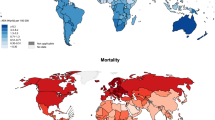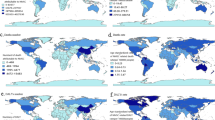Abstract
The variation with latitude of incidence and mortality for cutaneous malignant melanoma (CMM) in the non-Maori population of New Zealand was assessed. For those aged 20 to 74 yeas, the effects of age, time period, birth-cohort, gender, and region (latitude), and some interactions between them were evaluated by loglinear regression methods. Increasing age-standardized incidence and mortality rates with increasing proximity to the equator were found for men and women. These latitude gradients were greater for males than females. The relative risk of melanoma in the most southern part of New Zealand (latitude 44° S) compared with the most northern region (latitude 36° S) was 0.63 (95 percent confidence interval [CI]=0.60–0.67) for incidence and 0.76 (CI=0.68–0.86) for mortality, both genders combined. The mean percentage change in CMM rates per degree of latitude for males was greater than those reported in other published studies. Differences between men and women in melanoma risk with latitude suggest that regional sun-behavior patterns or other risk factors may contribute to the latitude gradient observed.
Similar content being viewed by others
References
Parkin DM, Muir CS, Whelan SL, Gao YT, Ferlay J, Powell J, eds.Cancer Incidence in Five Continents. Volume VI. Lyon, France: International Agency for Research on Cancer, 1992; IARC Sci. Pub. No. 120.
Levi F, Lucchini F, La Vecchia C. Worldwide patterns of cancer mortality, 1985–89.Eur J Cancer Prev (in press).
Jensen OM, Bolander AM. Trends in malignant melanoma of the skin.Wld Hlth Statist Quart 1980;33: 2–26.
Department of Statistics.1986 New Zealand Census of Population and Dwellings: Birthplaces and Ethnic Origin. Wellington, New Zealand: Department of Statistics, 1988.
Lancaster HO. Some geographical aspects of the mortality from melanoma in Europeans.Med J Aust 1956;1: 1082–7.
Magnus K. Incidence of malignant melanoma of the skin in Norway, 1955–70.Cancer 1973;32: 1275–86.
Elwood JM, Lee JAH, Walter SD, Mo T, Green ES. Relationship of melanoma and other skin cancer mortality to latitude and ultraviolet radiation in the United States and Canada.Int J Epidemiol 1974;3: 325–32.
Fears TR, Scotto J, Schneiderman MA. Skin cancer, melanoma, and sunlight.Am J Public Health 1976;66: 461–4.
Eklund G, Malec E. Sunlight and incidence of cutaneous malignant melanoma.Scand J Plast Reconstr Surg 1978;12: 231–41.
Teppo L, Pakkanen M, Hakulinen T. Sunlight as a risk factor of malignant melanoma of the skin.Cancer 1978;41: 2018–27.
Swerdlow AJ. Incidence of malignant melanoma of the skin in England and Wales and its relationship to sunshine.Br Med J 1979;2: 1324–7.
Holman CDJ, James IR, Gattey PH, Armstrong BK. An analysis of trends in mortality from malignant melanoma of the skin in Australia.Int J Cancer 1980;26: 703–9.
Scotto J, Fears TR. The association of solar ultraviolet and skin melanoma incidence among Caucasians in the United States.Cancer Invest 1987;5: 275–83.
Giles G, Dwyer T, Coates M, et al. Trends in skin cancer in Australia. An overview of the available data.Trans Menzies Found 1989;15: 143–7.
Moan J, Dahlback A. The relationship between skin cancers, solar radiation and ozone depletion.Br J Cancer 1992;65: 916–21.
Lee JAH, Scotto J. Melanoma: linked temporal and latitude changes in the United States.Cancer Causes Control 1993;4: 413–8.
Hakulinen T, Teppo L, Saxen E. Cancer of the eye, a review of trends and differentials.Wld Hlth Statist Quart 1978;31: 143–58.
Crombie IK. Variation of melanoma incidence with latitude in North America and Europe.Br J Cancer 1979;40: 774–81.
World Health Organization.International Classification of Diseases, Eighth Revision. Geneva, Switzerland: WHO, 1967.
Cooke KR, Gray AJ, Burry AF, Stewart RJ.Cancer Registration in New Zealand. Wellington, New Zealand: Department of Statistics, 1988, Report of the Cancer Registration Working Group.
Clayton D, Schifflers E. Model for temporal variation in cancer rates. II: age-period-cohort models.Stat Med 1987;6: 469–81.
Cooke KR. Melanoma registrations [Letter].N Z Med J 1992;105: 343.
Department of Statistics.Demographic Trends. Wellington, New Zealand: Department of Statistics, 1991.
Weinstock MA, Colditz GA, Willett WC, et al. Non familial cutaneous melanoma incidence in women associated with sun exposure before 20 years of age.Pediatrics 1989;84: 199–204.
Mack TM, Floderus B. Malignant melanoma risk by nativity, place of residence at diagnosis, and age at migration.Cancer Causes Control 1991;2: 401–11.
Moss ALH. Malignant melanoma in Maoris and Polynesians in New Zealand.Br J Plast Surg 1984;37: 73–5.
McKenzie RL, Elwood JM. Intensity of solar ultraviolet radiation and its implications for skin cancer.N Z Med J 1990;103: 152–4.
Cooke KR, Skegg DCG, Fraser J. Trends in malignant melanoma of skin in New Zealand.Int J Cancer 1983;31: 715–8.
Houghton A, Munster EW, Viola MV. Increased incidence of malignant melanoma after peaks of sunspot activity.Lancet 1978;1: 759–60.
Wigle DT. Malignant melanoma of skin and sunspot activity [Letter].Lancet 1978;2: 38.
Armstrong BK, Heenan PJ, Caruso V, Glancy RJ, Holman CDJ. Seasonal variation in the junctional component of pigmented naevi.Int J Cancer 1984;34: 441–2.
Elwood JM. Epidemiology of melanoma: its relationship to ultraviolet radiation and ozone depletion. In: Russell-Jones R, Wygley T, eds.Ozone Depletion: Health and Environmental Consequences. London, UK: Wiley, 1989: 169–89.
Lee JAH. Melanoma and exposure to sunlight.Epidemiol Rev 1982;4: 110–32.
Jones ME, Shugg D, Dwyer T, Young B, Bonett A. Interstate differences in incidence and mortality from melanoma. A re-examination of the latitudinal gradient.Med J Aust 1992;157: 373–8.
Author information
Authors and Affiliations
Additional information
This work was carried out during the tenure(by J-L.B.) of a Training Scholarship from the Swiss League Against Cancer.
Rights and permissions
About this article
Cite this article
Bulliard, JL., Cox, B. & Elwood, J.M. Latitude gradients in melanoma incidence and mortality in the non-Maori population of New Zealand. Cancer Causes Control 5, 234–240 (1994). https://doi.org/10.1007/BF01830242
Received:
Accepted:
Issue Date:
DOI: https://doi.org/10.1007/BF01830242




